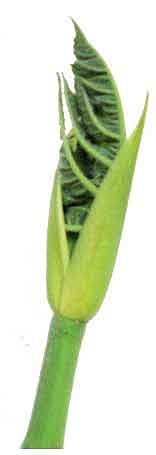 General
info General
info
- Artocarpus
is a genus of some 60 trees of Southeast Asian origin, belong to the
family Moraceae. The word Artocarpus is derived from the Greek words
artos (bread) and karpos (fruit).
- Artocarpus blancoi is a species of plant in the family Moraceae, endemic to the Philippines, its habitat threatened.
-
It is said Antipolo City, the capital of Rizal, derived its name from the Antipolo tree, at a time when the tree grew in abundance locally.
 Botany Botany
Antipolo is a large tree, growing up to 30 meters tall. Its habit, size,
and leaf characteristics are similar to Artocarpus altilis (Rimas). Leaves are simple, spirally arranged, with one to three pairs of lobes. Hairy petioles are about 8 centimeters long. Hairy stipules are about 10 centimeters long. Male inflorescence is smooth and cylindric, 5 to 8 centimeters long, flexuous, with spine-like structures. Fruit is ellipsoid, 10 centimeters long, 7 centimeters in diameter, ripening to yellow and orange-brown. Anthocarps are extended into 1-centimeter long, spiculate appendages. Seeds are ellipsoid, about 1 centimeter long, embedded in the fleshy part of the flesh.
Distribution
- Endemic species.
-
Found throughout the Philippines, in thickets and forests,
at low and medium altitudes.
- IUCN Red List of Threatened Species: Listed as vulnerable, 1998.
(9)
Constituents
- Qualitative phytochemical screening of crude ethanol extract of leaves yielded moderate presence of glycosides and sterols and trace amounts of triterpenes, flavonoids, saponins, and tannins. (see study below) (8)
- Phytochemical analysis of bark and leaf extracts yielded alkaloids, anthraquinones, cyanogenic glycosides, flavonoids, saponins, steroids, and tannins. (see study below)
(11)
Properties
- Bark extract considered antimicrobial.
- Studies have suggested antimicrobial, ovicidal, larvicidal, antioxidant, antiproliferative, adhesive properties.
Parts
utilized
Bark, roots.
 Uses Uses
Edibility
- Leaves reportedly used as food by the Ayta people in Porac, Pampanga. (1)
- Fruits and seeds are cooked and eaten.
- Ayta Magbukon cook young fruits in gata (Inluto in gata).
Folkloric
- Decoction of the two-parts bark of antipolo and one-part roots of Fleurya interrupta
(Lipang aso) is used for strangularia.
- The Aetas of Zambales burn the leaves of antipolo, its ashes then mixed with oil and applied to infected superficial skin diseases or "galis".
Others
- Wood: Used for carving and light construction.
- Fiber: Used as fiber plant for making pulp and paper. (4)
- Rope: Bast makes a weak rope, used for yoking buffaloes.
- Repellent: Ayta people burn dry leaves to repel mosquitoes. (2)
- Hunter's sap: Sticky sap from Tipolo placed on tall trees to capture to capture small birds. (6)
Studies
• Antimicrobial: Study evaluated 848 solvent extracts from 106 species of Philippine plants belong to 44 families for antimicrobial activity. Of the plants, 62 to 58 percent yielded constituents with inhibitory activity to B. subtilis, M. aureus, E. coli and Mycobacterium tuberculosis. Artocarpus blancoi was one of the 9 most active plants which demonstrated exceptionally high values of antimicrobial activity. (5)
• Gum / Drug Suspending Agent: Study evaluated gummy exudates obtained from incised bark of antipolo tree for potential pharmaceutical use as suspending agent. Physiochemical properties of crude gum suspension i.e. pH, viscosity, redispersibility time, sedimentation volume and degree of flocculation, were statistically comparable to standard acacia gum suspension. Results suggest the crude extract is a suitable alternative to imported acacia gum as suspending agent. (6)
• Larvicidal / Ovicidal / Aedes aegypti / Leaves: Targeting the vector is one of ways for Dengue control Study evaluated crude ethanol extract and fractions of leaves of Artocarpus blancoi for larvicidal and ovicidal activities against Aedes aegypti. An ethyl acetate soluble fraction showed lowest LC50 value (18.59 pp) followed by crude ethanol (411 ppm), hexane (685 ppm) and aqueous (20,158 ppm) fractions. The EA fraction was also the most ovicidal (80 ppm). Activities were dose-dependent (see constituents above) (6)
• Xanthine Oxidase Inhibitory Activity / Anti-gout Potential / Bark: Study of bark of Artocarpus blancoi exhibited xanthine oxidase inhibitory activity at 64.64%. Purification of active compound using bioassay-guided identified 5,7,4'-trihydroxyflavanone-3-O-α--L-rhamnopyranosie. Activity was comparable to positive control allopurinol. (10)
• Antioxidant / Cytotoxicity / Bark and Leaves: Study evaluated the phytochemical properties, antioxidant activity and cytotoxicity of bark and leaf extracts of A. blancoi. Ethanol extracts showed high mortality of A. salina naupliii (100%) at 100 ppm to 1000 ppm with LC50 of <10 after 6 and 24 h exposure while bark and leaf decoction showed LC50 value of >1000 after 6 and 24 h exposure. Both extracts showed strong free radical scavenging with LC50 of 5.2 µg/mL and 5.3 µg/mL, respectively. Results suggest strong antioxidant properties and very low lethality. (see constituents above) (11)
• Antibacterial / Antiproliferative: Extracts of Artocarpus blancoi, Ancistrocladus tectorius, and Pentacme siamensis produced significant growth-inhibitory effects (MICs 32-512 µg/ml) against intestinal pathogenic bacteria at concentrations non toxic to normal intestinal cells (IC80 >512 µg/ml; SI 0.11-0.2). A. blancoi showed strong anticlostridial action. P. siamensis together with A. blancoi selectively inhibited intestinal cancer cells (IC50s ≥51.98 to 130.89 µg/ml). The combination of strong anticlostridial and anticancer actions of A. blancoi suggests potential for the treatment of digestive cancers associated with C. difficile infections. (12)
• Adhesive Potential: Study reports on the formulation of adhesives using different combinations of gums from jackfruit and antipolo tree upon tapping. Measures observed were consistency, effectiveness, and general acceptability. Formulation(Treatment) 2, which contained 5 milliliters hot water, 20 gm flour, 15 milliliters jackfruit sap, and 15 milliliters of antipolo sap, was "significantly different" in terms of consistency and had best loading capacity of 17.50 kg. (13)
Availability
Wild-crafted. |



